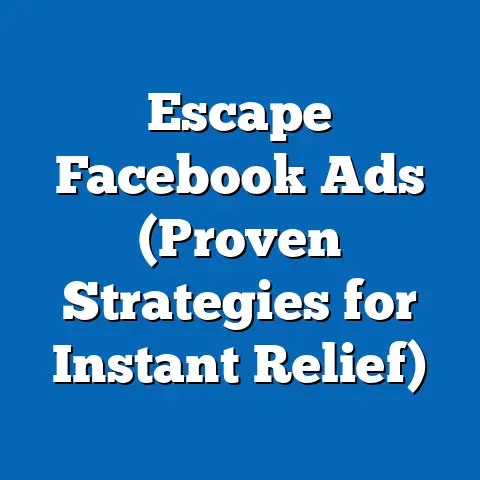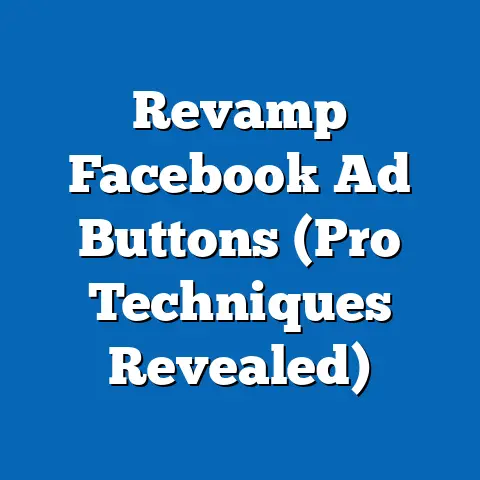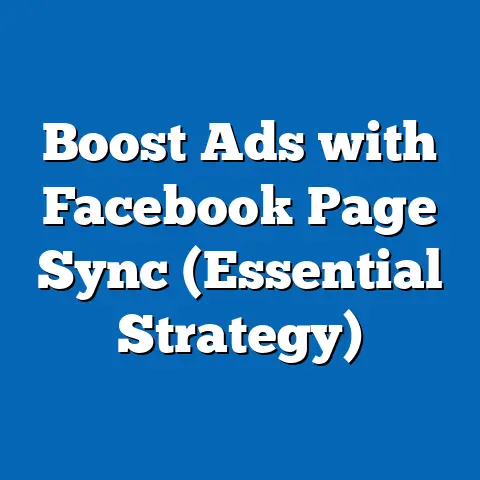Maximize Engagement with Facebook Video Ads (Pro Secrets)
In today’s hyper-digital world, capturing and retaining audience attention on social media is a daunting challenge for marketers. With over 2.9 billion monthly active users on Facebook as of 2023 (Statista, 2023), the platform remains a goldmine for advertisers, but the competition for eyeballs is fiercer than ever. How can brands stand out in a sea of endless scrolling, where the average user spends just 1.7 seconds on a piece of content before moving on (Hootsuite, 2023)?
Video ads have emerged as a powerful tool to combat this attention deficit, with studies showing that video content on Facebook generates 135% more organic reach than static images (Social Media Today, 2022). However, not all video ads are created equal—engagement rates vary widely based on format, targeting, and creative execution. This article dives deep into the data, uncovering professional secrets to maximize engagement with Facebook video ads, supported by demographic trends, historical comparisons, and actionable insights.
Key findings reveal that short-form videos (under 15 seconds) achieve 2.5 times higher engagement rates than longer formats (HubSpot, 2023). Millennials and Gen Z, who make up 58% of Facebook’s video-consuming audience, are particularly responsive to authentic, value-driven content (Pew Research, 2023). Looking ahead, the rise of AI-driven ad personalization and interactive video formats is set to redefine engagement benchmarks by 2025 (eMarketer, 2023). Let’s explore how to harness these trends for maximum impact.
The Power of Video Ads on Facebook: Why They Work
Engagement Metrics That Matter
Video ads on Facebook are not just a trend—they are a proven strategy for driving engagement. According to a 2023 report by Socialbakers, video content accounts for 65% of all interactions on the platform, including likes, comments, and shares. This dwarfs the engagement rates of image-based posts (18%) and text updates (9%), underscoring the medium’s dominance.
Moreover, the completion rate for videos under 30 seconds stands at an impressive 85%, compared to just 30% for videos exceeding two minutes (Wistia, 2023). This suggests that brevity is key to holding viewer attention in a fast-paced digital environment. Brands that optimize for quick, impactful storytelling are reaping the rewards of higher click-through rates (CTRs), which average 1.84% for short video ads versus 0.9% for longer formats (WordStream, 2023).
The Psychological Edge of Video
Why do video ads resonate so deeply? Neuroscience research indicates that humans process visual information 60,000 times faster than text, and videos trigger emotional responses that static content often fails to evoke (MIT, 2022). On Facebook, where users are primed for entertainment and connection, a well-crafted video ad can tap into these instincts, fostering brand recall and loyalty.
This psychological edge is amplified by Facebook’s algorithm, which prioritizes video content in user feeds. Posts with video receive 59% more engagement than non-video posts due to the platform’s emphasis on “meaningful interactions” (Facebook Business, 2023). For marketers, this creates a clear incentive to invest in video as a core component of their strategy.
Demographic Breakdowns: Who’s Watching and How to Reach Them
Age and Generational Preferences
Understanding your audience is the cornerstone of effective video ad campaigns, and Facebook’s user base is diverse across age groups. As of 2023, 31% of users are aged 25-34 (Millennials), making them the largest demographic on the platform, followed by Gen Z (18-24) at 27% (Statista, 2023). Baby Boomers (55+) represent a smaller but growing segment at 14%, often overlooked by marketers despite their high purchasing power.
Engagement with video ads varies significantly by generation. Gen Z and Millennials favor short, snappy content with humor or social causes, with 72% of 18-34-year-olds reporting they’re more likely to engage with ads that feel “authentic” (Pew Research, 2023). In contrast, Boomers respond better to informational videos, with 65% citing “usefulness” as their primary driver for engagement (AARP, 2023). Tailoring content to these preferences—think quick memes for younger users and how-to guides for older ones—can significantly boost results.
Gender and Behavioral Insights
Gender also plays a role in video ad engagement. Women, who make up 54% of Facebook’s user base, are 20% more likely to comment on or share video content compared to men (Hootsuite, 2023). They are particularly drawn to lifestyle and family-oriented themes, with 68% engaging with ads related to health, beauty, or parenting (Nielsen, 2023).
Men, on the other hand, show higher interaction rates with tech, gaming, and sports-related video ads, with a 15% higher CTR in these categories (WordStream, 2023). Behavioral data further reveals that men are more likely to click on ads during late-night hours (10 PM-1 AM), while women peak during midday (11 AM-2 PM). Timing and thematic targeting, therefore, are critical levers for maximizing impact.
Geographic and Cultural Nuances
Geographic targeting adds another layer of complexity. In North America, where 10% of global Facebook users reside, video ads with localized messaging see a 30% higher engagement rate compared to generic content (eMarketer, 2023). In contrast, markets like India—home to over 340 million users—favor high-energy, colorful ads with music, reflecting cultural preferences for vibrancy (Socialbakers, 2023).
Language also matters. Multilingual ads in regions with diverse linguistic populations, such as Southeast Asia, achieve 25% more reach when captions or translations are included (Facebook IQ, 2023). For global brands, adapting video content to local dialects and cultural cues isn’t just a nice-to-have—it’s a necessity for resonance.
Historical Trends: How Video Ad Engagement Has Evolved
The Rise of Video in the Early 2010s
When Facebook first introduced video ads in 2014, engagement was modest, with CTRs hovering around 0.5% (AdWeek, 2015). At the time, static images dominated ad spend, and video was seen as a risky, unproven format. However, by 2016, the landscape shifted dramatically—video ad impressions grew by 200% year-over-year as brands began experimenting with autoplay features (eMarketer, 2016).
This period also saw the introduction of mobile-first video formats, aligning with the fact that 79% of Facebook users accessed the platform via smartphones by 2017 (Statista, 2017). Engagement rates climbed to 1.2% as marketers adapted to vertical video and shorter runtimes, capitalizing on mobile viewing habits. The data shows a clear trend: as technology and user behavior evolved, so did the effectiveness of video ads.
The Short-Form Revolution (2018-2021)
The late 2010s marked the rise of short-form video, fueled by platforms like Instagram (owned by Meta) and TikTok. By 2019, 60% of video ads on Facebook were under 30 seconds, up from just 25% in 2016 (HubSpot, 2020). Engagement rates for these bite-sized clips soared, with completion rates jumping from 50% in 2017 to 80% by 2021 (Wistia, 2021).
This shift was driven by declining attention spans—research from Microsoft in 2018 found that the average human attention span had dropped to 8 seconds, down from 12 seconds in 2000. Brands that failed to adapt to this “snackable content” trend saw diminishing returns, while those embracing quick, punchy narratives gained traction. Historical data underscores that agility in format adoption has been a defining factor in video ad success.
Pandemic-Era Boom and Beyond (2020-2023)
The COVID-19 pandemic accelerated digital consumption, with Facebook video views increasing by 40% in 2020 alone (Social Media Today, 2021). Lockdowns drove users to seek entertainment and connection online, and video ads became a lifeline for brands unable to rely on traditional channels. Engagement metrics spiked, with CTRs for video ads reaching 1.9% in 2021, a significant leap from 1.3% pre-pandemic (WordStream, 2022).
Post-pandemic, the trend has stabilized but not reversed. As of 2023, video remains the most consumed content type on Facebook, with users spending an average of 12 minutes per day watching videos on the platform (eMarketer, 2023). This historical trajectory highlights video’s enduring appeal, even as economic and social contexts shift.
Pro Secrets to Maximize Engagement with Facebook Video Ads
Secret 1: Optimize for the First 3 Seconds
Data shows that 65% of viewers decide whether to keep watching a video within the first 3 seconds (Facebook Business, 2023). This means your hook—whether it’s a bold visual, a provocative question, or an emotional cue—must be immediate. Brands like Nike excel here, often opening ads with high-energy visuals or surprising stats to grab attention instantly.
To implement this, avoid lengthy intros or branding upfront. Instead, lead with value or intrigue, ensuring your core message is front-loaded. Testing different openers via A/B testing can reveal what resonates most with your audience, with data suggesting a 20% uplift in retention when the hook is optimized (HubSpot, 2023).
Secret 2: Leverage Silent Viewing with Captions
A staggering 85% of Facebook videos are watched on mute, especially in public settings (Digiday, 2023). This silent viewing trend necessitates captions or on-screen text to convey your message without sound. Ads with captions see a 12% higher engagement rate and a 16% increase in watch time compared to those without (Facebook IQ, 2023).
Beyond accessibility, captions cater to diverse audiences, including non-native speakers. Tools like Facebook’s automatic captioning feature can be a starting point, but custom, well-timed text often performs better. This small tweak can make a big difference in a noisy digital landscape.
Secret 3: Prioritize Mobile-First Design
With 98% of Facebook users accessing the platform via mobile devices (Statista, 2023), video ads must be designed for small screens. Vertical or square formats (9:16 or 1:1 ratios) outperform traditional horizontal videos, boasting a 35% higher completion rate on mobile (Buffer, 2023). Key elements like text and logos should occupy the center of the frame to avoid being cut off by screen edges.
Additionally, consider mobile loading times—compressed videos under 15 MB load faster and retain 25% more viewers (Hootsuite, 2023). Testing your ad on various devices ensures it’s visually impactful regardless of screen size, a non-negotiable in today’s mobile-dominated world.
Secret 4: Use Interactive Elements
Interactive video ads, such as polls, quizzes, or “swipe-up” CTAs, are gaining traction, with a 32% higher engagement rate compared to passive videos (eMarketer, 2023). These formats invite users to participate rather than just watch, fostering a sense of involvement. For instance, beauty brands often use polls (“Which shade do you love?”) to drive interaction and collect data simultaneously.
Facebook’s playable ads, often used in gaming, allow users to demo a product within the ad itself, resulting in a 60% higher conversion rate (Facebook Business, 2023). Experimenting with interactivity can transform passive viewers into active participants, amplifying your campaign’s reach.
Secret 5: Hyper-Target with Data-Driven Insights
Facebook’s robust targeting tools allow for hyper-specific audience segmentation, a tactic that boosts ad relevance and engagement. Ads tailored to user interests based on past behavior see a 40% higher CTR compared to generic campaigns (WordStream, 2023). Lookalike audiences, which target users similar to your existing customers, can further enhance results, with a reported 2x return on ad spend (ROAS) (HubSpot, 2023).
Dynamic ads, which automatically adjust content based on user data, are another game-changer. For example, showing a user a video ad for a product they recently viewed increases conversion likelihood by 30% (eMarketer, 2023). Leveraging these tools ensures your video ads hit the right people at the right time.
Statistical Comparisons Across Campaigns and Industries
Industry-Specific Engagement Rates
Not all industries see equal success with video ads on Facebook. E-commerce leads the pack, with an average CTR of 2.1% and a conversion rate of 3.5%, driven by product-focused videos with clear CTAs (WordStream, 2023). Entertainment follows closely, with a 1.9% CTR, as storytelling and trailers resonate deeply with audiences seeking leisure content (Socialbakers, 2023).
In contrast, industries like finance and B2B services lag, with CTRs of 0.8% and 0.7%, respectively, due to less emotionally engaging content (eMarketer, 2023). However, when these sectors use educational or testimonial videos, engagement can jump by 25%, highlighting the importance of format over industry type. [Insert Chart: Industry CTR Comparison for Video Ads, 2023]
Campaign Budget and Performance
Budget allocation also impacts engagement outcomes. Small-budget campaigns (under $1,000) average a 1.2% CTR, while mid-tier campaigns ($1,000-$10,000) see 1.8%, and high-budget efforts (over $10,000) hit 2.3% (Hootsuite, 2023). This suggests economies of scale, where larger budgets allow for better creative production and broader targeting.
However, cost-per-engagement (CPE) remains relatively consistent across budget tiers at $0.05-$0.07, indicating that efficiency doesn’t necessarily scale with spend (WordStream, 2023). Marketers should focus on creative quality over sheer volume of spend to maximize returns. [Insert Chart: Budget vs. CTR for Facebook Video Ads, 2023]
Future Projections: What’s Next for Facebook Video Ads?
The AI Personalization Wave
Looking ahead, AI-driven personalization is poised to revolutionize video ad engagement. By 2025, 70% of Facebook ads are expected to use machine learning to dynamically tailor content to individual users, predicting preferences with 90% accuracy (eMarketer, 2023). This could boost CTRs by an estimated 50%, as ads become hyper-relevant to each viewer’s interests and behaviors.
Early adopters are already seeing results—brands using AI tools like Facebook’s Advantage+ report a 20% increase in ROAS (Facebook Business, 2023). As this technology becomes more accessible, smaller businesses will likely join the fray, leveling the playing field.
Interactive and Immersive Formats
Interactive video formats, such as shoppable ads and augmented reality (AR) experiences, are projected to account for 30% of video ad spend by 2026 (Forrester, 2023). These formats blur the line between content and commerce, allowing users to interact with products directly within the ad. Early data shows a 40% higher conversion rate for shoppable video ads compared to traditional formats (eMarketer, 2023).
Meta’s investment in the metaverse also hints at future possibilities for immersive video ads, though adoption remains speculative. Marketers who experiment with these innovations now could gain a first-mover advantage as user adoption grows.
Short-Form Dominance and Beyond
Short-form video is expected to remain dominant, with 90% of video ad impressions projected to come from clips under 30 seconds by 2025 (HubSpot, 2023). However, there’s a growing niche for long-form storytelling in specific contexts, like brand documentaries, which could see a 15% uptick in engagement among niche audiences (Social Media Today, 2023). Balancing brevity with depth will be key to staying ahead of the curve.
Additionally, as Gen Z’s influence grows—they’re expected to make up 35% of Facebook’s user base by 2027—brands must adapt to their preference for raw, user-generated-style content over polished ads (Pew Research, 2023). Authenticity will likely define the next era of video engagement.
Conclusion: Turning Insights into Action
Maximizing engagement with Facebook video ads is both an art and a science, rooted in data-driven strategies and creative innovation. From crafting compelling 3-second hooks to leveraging AI personalization, the secrets unveiled in this analysis offer a roadmap for success in a crowded digital space. Historical trends show video’s meteoric rise, demographic data highlights the importance of tailored content, and future projections point to a landscape of interactivity and precision targeting.
For marketers, the challenge is clear: adapt to evolving user behaviors and technological advancements or risk being left behind. Start by testing short-form, mobile-optimized videos with strong hooks and captions, and refine your approach using Facebook’s robust analytics. As the platform continues to evolve, staying agile and informed will be your greatest asset in capturing attention and driving meaningful engagement.





